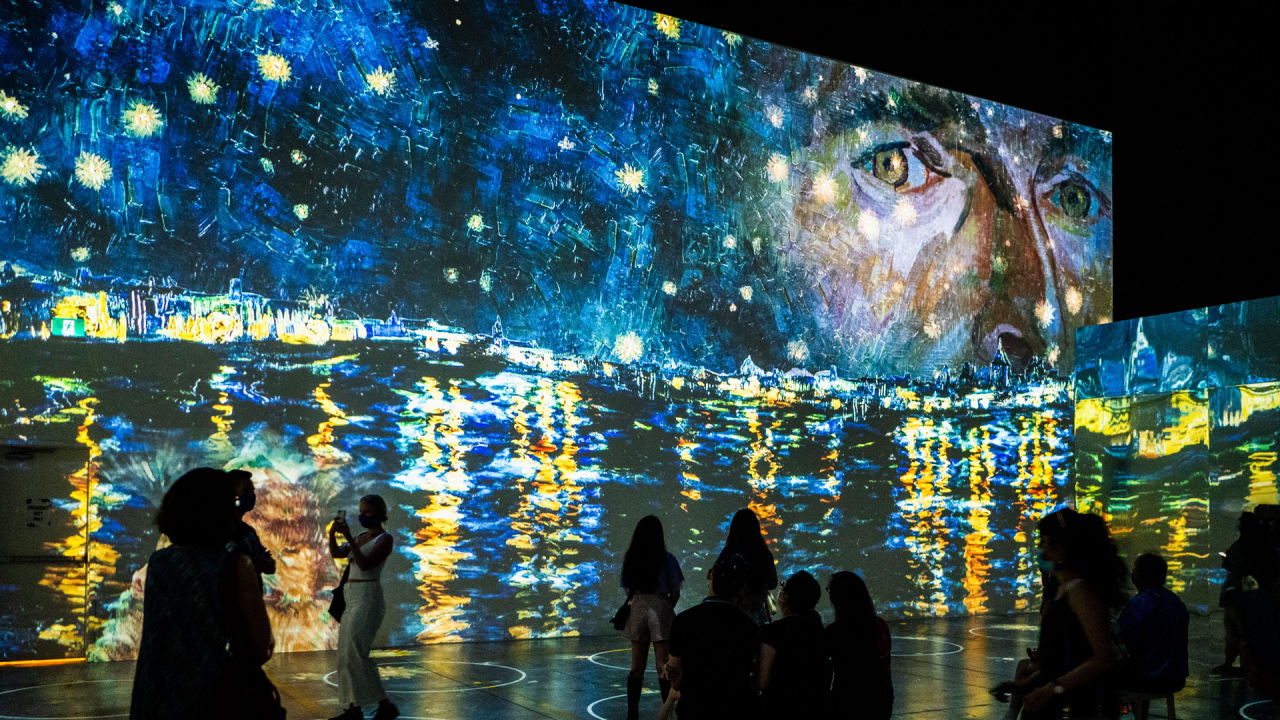In a giant room above a former car dealership in the center of San Francisco, a plethora of huge, brightly colored sunflowers is being laser-projected onto a 27-foot-high wall. Soon, the sunflowers fade into a series of animated swirls, blinking stars, and vivid depictions of the lights of a late-19th-century French village reflected in an undulating river. And then four faces appear—each an upside-down self-portrait of Vincent van Gogh. Standing on a riser about 10 feet above the floor, you feel like you’re deep inside an animated interpretation of one of the famous Dutch artist’s most celebrated paintings, The Starry Night . [Photo: courtesy of Immersive Van Gogh ] That’s exactly the experience the producers of Immersive Van Gogh want to invoke . The traveling exhibition—currently on display in Chicago, opening in San Francisco on March 18, and coming soon to other cities around the country—explores the artist’s final days before he took his own life to escape his madness. “It’s what you see in front of your eyes before you die,” explains Svetlana Dvoretsky, a coproducer of the show. “It’s taking you inside the mind of the genius and showing you what he saw.” Because van Gogh’s work is in the public domain, there are several different “immersive” exhibits showcasing his art making the rounds of the country at the moment. But Dvoretsky says Immersive Van Gogh stands out from the crowd thanks to its singular approach—not simply projecting paintings on a wall, but rather interpreting and deconstructing the work and creating all-new animated representations of 60 van Gogh paintings, including Starry Night , Sunflowers , and The Bedroom . As stated in promotional materials, the exhibit presents the work “as how the artist first saw the scenes they are based on: active life and moving landscapes turned into sharp yet sweeping brushstrokes.” [Photo: courtesy of Immersive Van Gogh ] Created by Massimiliano Siccardi, the exhibit may seem familiar to anyone who watched the Netflix hit Emily in Paris , which features a vivid and arresting scene at an earlier version of the show in the French capital. And while Immersive Van Gogh will run simultaneously in several cities—and has already completed successful runs in other countries—each iteration was designed specifically for its venue. For the San Francisco version, explains Brandon Charlton, one of the show’s production managers, that meant finding a way to project the 37-minute experience onto the 27-foot-high walls without any shadows getting in the way of what visitors see or having the imagery look in any way anything less than seamless. All told, he says, it took the crew 140 hours to integrate the imagery from 40 laser projectors. The result is stunning. In the giant room, visitors examine the animation from countless angles—even lying down on the floor and staying as long as they like through multiple plays of the loop—and enjoy crystal-clear imagery composed of 65 million pixels and 56,000 frames of video. Behind the scenes, one master computer is controlling 11 servers, all of which are connected to 8 miles of cable, with the 40 projectors mounted on 510 feet of truss. [Photo: courtesy of Immersive Van Gogh ] One obvious challenge of putting on an exhibit like this during a pandemic is how to make it safe. The producers have solved that with timed tickets and a series of social-distancing circles projected on the floor—not to mention standard COVID-19-era precautions such as a mask mandate, temperature checks, and hand sanitizer stations. But Charlton adds that, although Immersive Van Gogh was designed before the onset of the pandemic, it lends itself perfectly to safety protocols because of the wide-open spaces in which it’s presented. Indeed, he says, producers didn’t have to change anything about the show other than adding the distancing circles.

Continued here:
This stunning immersive exhibit explores van Gogh’s art in a whole new way